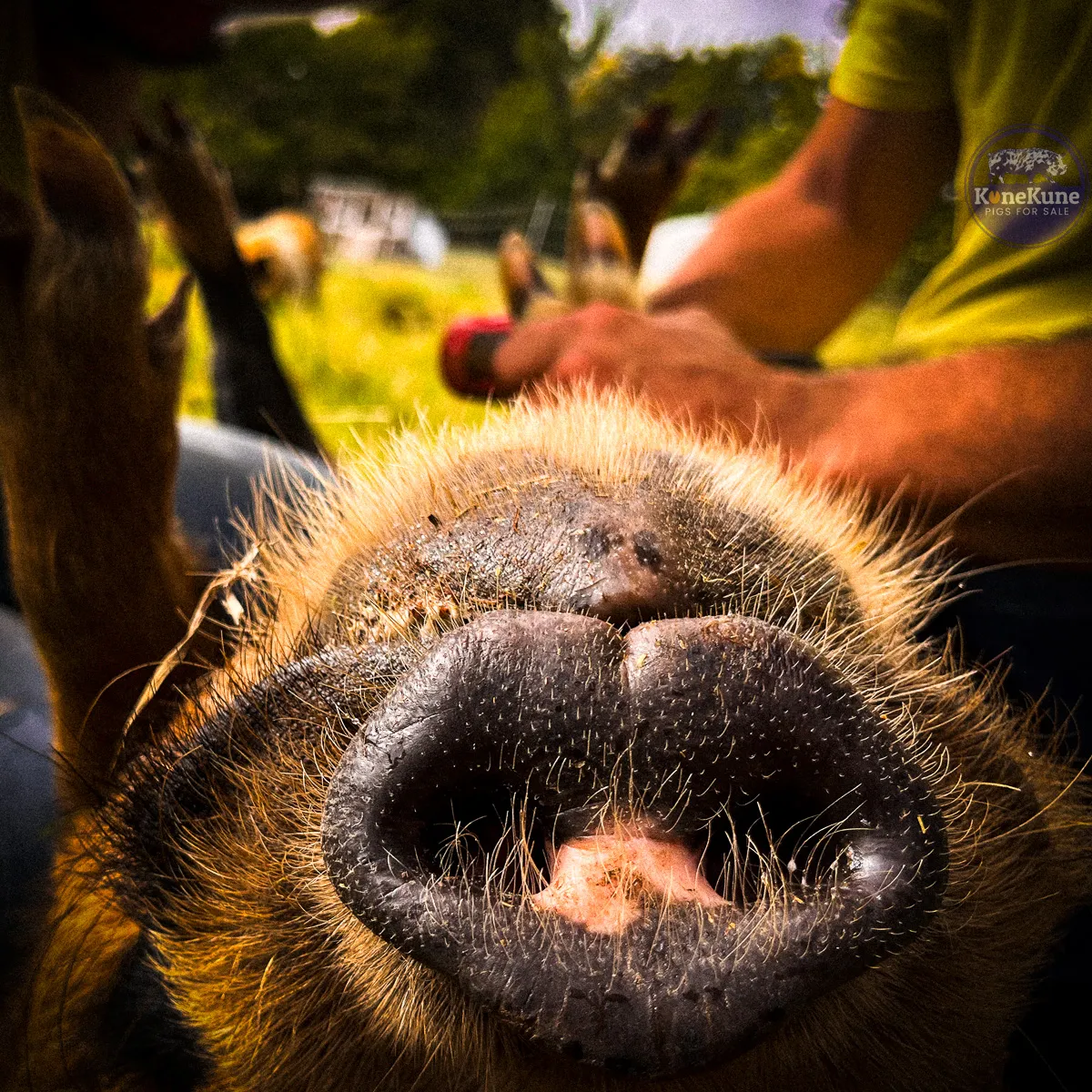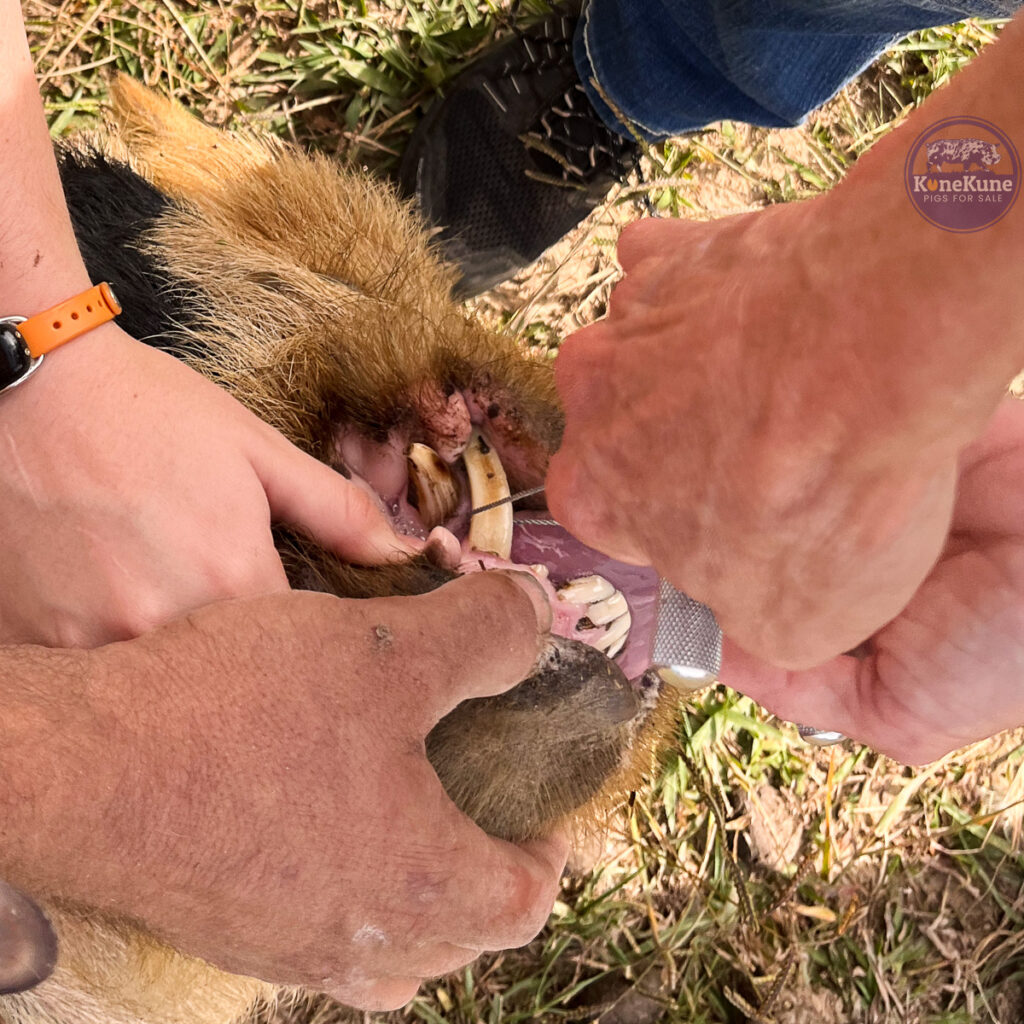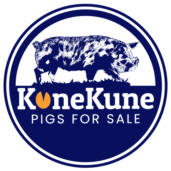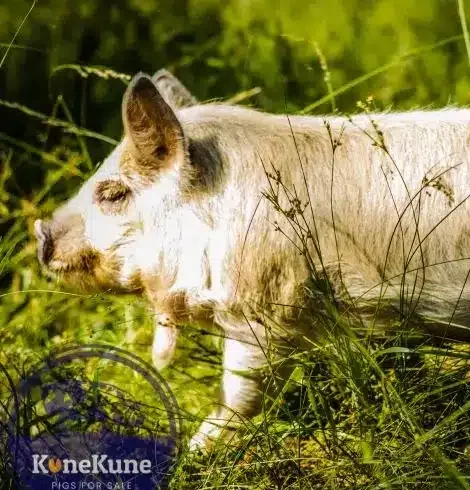Trimming KuneKune pig tusks is the process of carefully cutting the continuously growing tusks of a KuneKune pig. While not all pigs need their tusks trimmed, some KuneKunes develop pronounced tusks that can become unruly, get caught on objects, or even curl back towards the face. That’s where tusk trimming comes in – when done properly, it’s a safe procedure that keeps your KuneKune’s tusks neat and tidy.
In this article, we’ll first cover whether you should trim your KuneKune’s tusks and how often to do it. We’ll discuss the risks of not trimming and if the process hurts pigs. Then we’ll compare different trimming methods – flipping, snares and sedation – so you can decide the best approach. Next, we’ll go over the tools you’ll need. Finally, we’ll provide a step-by-step guide for how to humanely and safely trim tusks. By the end, you’ll be fully prepared to determine if and how to trim your KuneKune’s tusks.

Should You Trim Your KuneKunes Tusks?
Ultimately, the decision to trim your KuneKune pig’s tusks is up to you as the owner. However, we believe it is in the best interest of the pig’s health and safety to keep tusks trimmed. Overly long tusks can curl back towards the face, get caught on objects, or make breeding difficult. This can cause injuries or distress. Additionally, trimmed tusks are safer for owners handling the pigs. The tusks are less likely to inadvertently scratch or poke.
Now that we’ve established the benefits of trimming, let’s explore some key considerations in how often you should trim your KuneKune’s tusks.
How Often to Trim KuneKune Tusks?
When it comes to trimming frequency, a KuneKune boar’s tusks should be trimmed 1-2 times per year, depending on the individual pig’s tusk growth rate. Many experts recommend trimming around key events like re-mixing boars after breeding season and before putting them in with sows. This helps prevent tusk-related injuries during breeding.
Many factors affect the growth rate of tusks such as:
- Breed: Heritage breeds like KuneKunes have slower tusk growth rate than commercial breeds.
- Gender: Testosterone has the biggest impact on tusk growth, therefore Female (Sow) tusk growth rate is much slower than a male (boars).
- Age: Typically initial trimmings for boars aren’t necessary until the pig reaches about 1.5-3 years old.
- Diet: As KuneKune pigs are natural grazers this helps slow tusk development. Commercial feed causes an increase in growth.
- Health Issues: Overgrown tusks can cause chewing issues, misaligned bites, or facial piercing if not managed.
For sows, trimming may only be needed once every few years, as their tusks grow slower. Check your pig’s tusks regularly and trim as soon as the tusks start to curl or become unruly.

Now that we’ve covered trimming frequency and growth factors, let’s discuss some of the risks and potential injuries that can occur if KuneKune tusks are not properly managed.
What Are the Risks of Not Trimming Pig Tusks?
If KuneKune tusks are not trimmed regularly, several risks and potential injuries can occur. Overly long tusks may curve back towards the face, eventually piercing the cheek or even puncturing the eye. This can cause severe infections and pain.
Unchecked tusks are also prone to cracking or breaking which exposes the sensitive pulp cavity. Additionally, long tusks often get caught on fencing, feeders, housing materials and other objects. This can panic the pig and lead to dangerous tusk avulsion if forcefully yanked.
Males (Boars) may have trouble cleanly breeding females (Sows) without injuring them. And finally, long sharp tusks pose handling risks to human caretakers who can be scratched, gouged or poked even playfully. Given these many risks, proactive tusk trimming is strongly recommended for KuneKunes.
While those risks make a good case for trimming, some owners may be hesitant because they worry the process itself could hurt or distress their beloved KuneKune pigs.
Does Trimming Pigs Tusks Hurt Your Pigs?
Trimming a Pigs Tusk when done correctly using proper techniques, is not a painful or distressing process. Using gentle restraint methods suitable for the pig’s size and temperament can help minimize stress. Most young KuneKunes can be safely held or cradled without sedation to access the tusks.
Since the tusks themselves contain no nerves or blood vessels, trimming at the appropriate length above the gum line prevents any sensitivity. Appropriate tools, trimming method, and aftercare also reduce irritation.
Overall, KuneKune pigs tend to tolerate routine trimming without lasting pain or behavior changes. They typically return to normal habits right after, showing no signs of distress. With the right approach, owners can humanely trim tusks without causing their pigs any undue discomfort.

The 3 Methods for Trimming Tusks: Pig Flip vs Snare vs Sedation
When it comes to tusk trimming methods, owners have three main options to consider – pig flipping, snares, and sedation.
- Pig Flipping: Involves cautiously rolling the pig on its side and stabilizing it to expose the tusks for trimming. This hands-on method can be done without sedation but requires adequate manpower.
- Snares: Using a lasso rope looped around the upper jaw to hold the mouth open during trimming. This restraint allows one person to do the trimming but can cause rubbing of the snout.
- Sedation: or anesthesia provides the greatest immobilization for trimming but has inherent risks and costs. It may be needed for older or more dangerous boars.
Each method has pros and cons depending on the pig’s age, size and temperament. Owners must choose the safest approach for their situation.
Why We Choose to Flip for Tusk Trimming?
For our KuneKune pigs, we choose to use the pig flipping method to trim tusks. We find this hands-on approach allows us to gently but securely restrain young pigs without sedation. Flipping gives full access to the tusks so we can carefully trim them above the gum line using an obstetrical wire.
Our pigs seem less stressed with human handling rather than snares around their snouts. We also prefer flipping to sedation since anesthesia carries risks, especially for repeat use. As long as we have extra help to safely roll and stabilize the pig, flipping has proven a reliable trimming method for our herd. It may not be right for all situations, but for us, flipping ticks all the boxes.
What are the Tools Needed for Trimming Tusks?
- Cutting wire – An obstetrical wire (Gigli Wire) works best. The thin, flexible steel allows control while the tungsten carbide coating provides a clean cut.
- Wire gripper/handle – Emasculators provide a comfortable grip for holding the wire taut.
- Safety glasses and gloves – Protect you during the trimming process.
- Antiseptic – Clean and disinfect the tusk edge after trimming to prevent infection.
- Mouth speculum (optional) – Keeps the mouth held open.
- Sedation or anesthesia (optional) – May be needed for older or dangerous boars.
- Restraint tools – Pig snares, rope, or flip boards to secure the pig safely if you are using those methods.
- Disinfectant soap and scrub brush – For cleaning the tusks before and after trimming.
How to Trim KuneKune Pigs Tusks?
Trimming your KuneKune’s tusks yourself is manageable with some preparation and assistance. Here are the step-by-step procedures:
- Have a Plan – Know your pig’s temperament and have your tools and help ready in advance. Prepare the trimming area to be free of obstacles.
- Roll Your Pig – Cautiously roll the pig onto its back. With one person on either side of the pig. This is critical to keep them stable.
- Stabilize – Gently hold the head and rear still to avoid sudden movements during trimming.
- Position the Wire – Insert the obstetrical wire (gigli wire) around the tusk’s base and grip the ends together.
- Saw the Tusk – In long back-and-forth motions, hold the wire taut against the tusk to cleanly saw it to the desired length.
- Repeat on Other Tusk – Reposition the pig if needed to access and trim the second tusk.
- Clean Tusks – Disinfect and scrub the trimmed tusks to keep the area clean.
- Return Pig – Slowly roll the pig back onto its feet/stomach and monitor its recovery.
- Provide Aftercare – Check for normal eating behaviors and watch for signs of infection.
Key Takeaways
Regularly trimming KuneKune tusks is recommended for pet pigs to prevent injuries, health issues, and handling safety concerns that can occur from overgrown tusks.
While some owners worry about pain, the trimming process does not hurt pigs when done properly using gentle restraint methods suitable for the pig, quality trimming tools, and good technique.
Trimming frequency depends on factors like the pig’s breed, age, diet, housing environment and health status, but plan for routine trims around 1-2 times per year on average.
For many most KuneKune Pigs, the pig flipping method with adequate human assistance allows safe DIY tusk trimming without the need for sedation. Having the right equipment on hand like an obstetrical wire, comfortable gripper, protective glasses and gloves, disinfectant, and mouth speculum facilitates an efficient trim. Following basic step-by-step procedures, KuneKune owners can learn to humanely trim their pig’s tusks at home.
Overall, maintaining properly trimmed tusks results in happier, healthier pigs and safer handling for owners.
<h3>Hoof Trimming is Also Key for KuneKune Maintenance</h3>
Hoof Trimming is Also Key for KuneKune Maintenance
Along with properly managing your KuneKune pig’s hooves, regularly trimming their tusks is an essential part of caring for these pets. Hooves and tusks that are not trimmed can cause discomfort, issues walking and feeding, and potentially serious injuries. Be sure to check both your pig’s hooves and tusks frequently and maintain them following best practices for health and safety.
FAQ on KuneKune Pig Tusks
How Much does it Cost to Have Pig Tusks Trimmed?
Generally a farrier will charge anywhere between $40-$80 to have your KuneKune Pig Tusks Trimmed, along with a trip charge.
Do Pig Tusks Have Nerves?
No, the tusk itself does not contain nerves. The nerve endings are in the tissue above the gum line.
Do Female (Sow) KuneKunes have Tusks?
Yes, female KuneKunes have tusks but they tend to be smaller and grow slower than males.
Why do KuneKune Pigs have Tusks?
Tusks are used by wild pigs for defense, digging, marking trees, and cracking hard foods. Domestic KuneKunes retain this natural anatomy.
Do all pigs have tusks?
Nearly all pig breeds develop some tusks, though size and growth rate varies depending on genetics.




